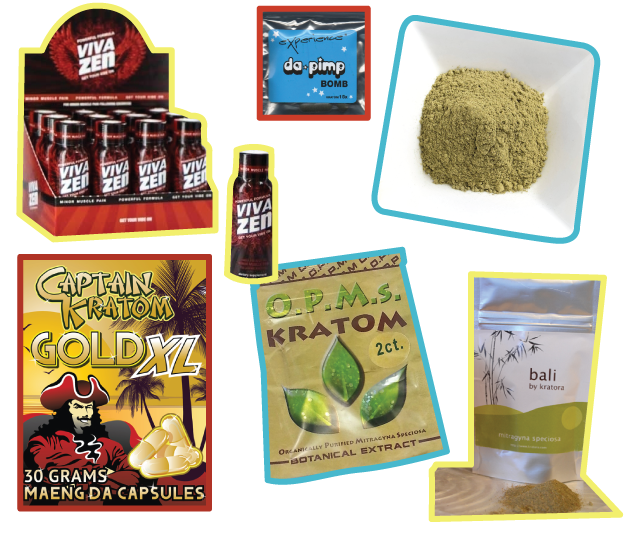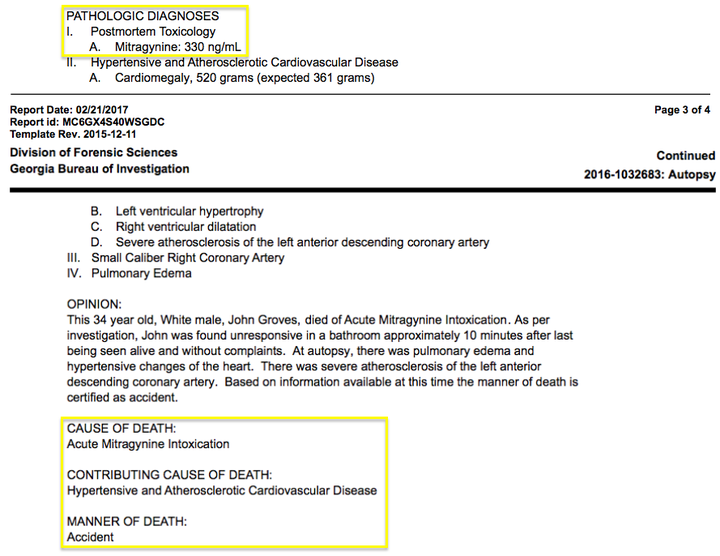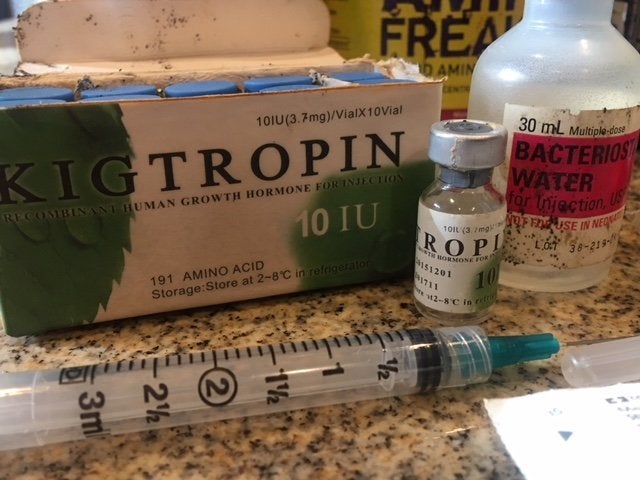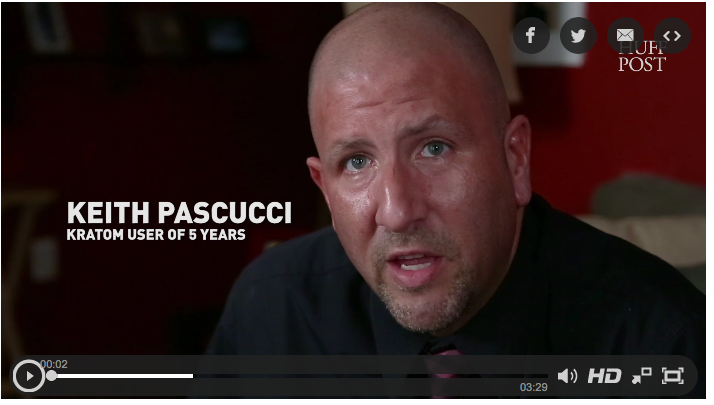HuffPost
Authorities claim the popular herbal drug poses potentially deadly risks, but there are big problems with their evidence.
It wasn’t just the 34-year-old’s hulking frame. At 6 feet 4 inches and nearly 270 pounds at autopsy, Grove’s muscular body showed few signs of the years he’d spent battling opioid addiction.
But when his toxicology test came back in January 2017, it revealed something unusual. There were no opioids in his system, nor were there cocaine or benzodiazepines, which are now responsible for the overwhelming majority of drug overdoses. Instead, Grove tested positive for a single substance: mitragynine, best known as the psychoactive ingredient of kratom, an herbal drug derived from the leaves of a Southeast Asian tree related to coffee.
And it was mitragynine that had caused Grove to collapse on the floor of his coworker’s bathroom and die, GBI concluded.
It was an odd and seemingly unprecedented determination. Scientists say there’s scant evidence that mitragynine causes fatal overdoses, and many kratom advocates claim that overdosing on the substance alone is impossible. Although authorities have come forward with reports of deaths supposedly related to kratom, all of the cases they’ve cited publicly have involved the presence of other, often more dangerous drugs, making it nearly impossible to discern kratom’s role in the fatalities.
But mitragynine was the only substance on Grove’s toxicology test. His death, listed as an “acute mitragynine intoxication,” could have provided an important window into how this drug supposedly kills humans when taken in isolation.
HuffPost took a closer look at Grove’s case and other “kratom-related deaths” in Georgia. We found that not only is the state using sloppy reporting on these deaths, likely overestimating the apparent harms of kratom, but the state also appears to be rushing to blame mitragynine for the deaths of people like Grove, even when there may be more likely culprits.

Grove was one of the first deceased individuals in Georgia to test positive for mitragynine, following GBI’s decision in November 2016 to begin routinely screening for the substance amid mounting concerns about kratom, according to records the agency provided to HuffPost.
There were four such kratom-related deaths in the state in 2016, according to GBI; and 11 more so far this year. Those figures recently led the state’s chief medical examiner to warn that kratom is killing people in Georgia.
But when HuffPost examined GBI’s data, it became clear that the agency is relying on a loose interpretation of what it means for a death to be “related” to kratom. In fact, it appears to be counting every fatal drug overdose in which mitragynine is present as a so-called kratom-related death.
Of the 15 cases GBI has documented, only four individuals tested positive for mitragynine alone. Grove was among them, though HuffPost has learned additional details which show that even in cases like his, mitragynine may not be the most probable killer.
Every other supposed kratom-related death in Georgia also involved additional substances, often including much stronger drugs like heroin, prescription drugs or other potent opioid analogs like fentanyl ― sometimes taken together.
In two of the cases GBI considers kratom-related deaths, the subjects tested positive for eight different substances, including opioids, antidepressants and other powerful prescription drugs. Due to the nature of GBI’s data collection methods, it considers these deaths to be kratom-related.

This system, which indiscriminately lumps cases into the same category despite glaring dissimilarities, says nothing about how ― or even if ― GBI determined mitragynine had actually contributed to each death.
GBI declined to comment to HuffPost about Grove’s examination, including what had led to the determination that he had died of “acute mitragynine intoxication,” as well as what such an incident actually looks like.
Using these loose reporting standards, officials in Georgia have been able to claim they have the data necessary to classify kratom as a potentially deadly drug.
But emerging science has found mitragynine to be largely benign, especially when taken in low or moderate doses. Additional research is needed to identify potential health conditions or genetic predispositions that could cause complications for kratom users. After all, if officials are genuinely interested in preventing harm related to kratom, they must first identify with certainty what that harm is.
GBI’s broad-brush treatment of kratom-related deaths does nothing to expand this understanding, and may actually obscure it by a producing a misleading narrative about mitragynine’s effects.

Kratom groups estimate that around 3 million people now use the substance in the U.S., where it’s sold over the counter as an herbal supplement and commonly taken as a powder or tea. More controversial products have also popped up in gas stations or head shops, where they may be hocked as a cheap high.
Mitragynine activates opioid receptors, but does so without triggering respiratory depression, an often lethal side effect of traditional opioids. Consumers use kratom for a variety of purposes, including as a treatment for chronic pain, anxiety and depression, as well as a replacement drug for opioid addiction.
In the face of a new drug scare, the federal government has predictably responded with promises of aggressive action to protect Americans. And it may be using Georgia’s reports on kratom-associated deaths ― or at the very least, a similarly suspect methodology ― to advance claims that the herbal supplement presents an imminent danger to public health.
Earlier this month, Food and Drug Administration Commissioner Scott Gottlieb issued a public health advisory outlining mounting fears about kratom’s “deadly risks.” Gottlieb specifically claimed his agency had identified total 36 deaths associated with kratom-containing products, and argued they were proof of the “increasing harms” of the drug.
The announcement signaled that the federal government was preparing to revive an effort to crack down on or ban kratom. The Drug Enforcement Administration postponed a similar push last year following intense public backlash, and is currently awaiting an official analysis from the FDA on kratom’s risk profile before deciding how to proceed. In an interview last month, Gottlieb suggested his agency had already provided the report to DEA.
The FDA has not revealed any further information about the 36 cases Gottlieb cited. It denied HuffPost’s request to immediately release the data, and has responded to other reporters’ requests by saying they couldn’t locate it. An FDA database that compiles reports of adverse drug interactions shows records of 42 kratom-related deaths since 2011. But all of the incidents on that list also involved the presence of other substances. Some of them took place abroad, and were related to a controversial adulterated kratom product that contains the opioid painkiller tramadol.
If the number the FDA is now citing includes cases from Georgia, or even other similar deaths from elsewhere, it is almost certainly exaggerated. At the very least, these questions show there must be more transparency when it comes to reporting on kratom-related deaths.
The tendency for public health officials and the media to run with these reports also suggests that there should be an independent review of the data to get a fuller understanding of what, if anything, these cases could actually say about mitragynine’s potential harms.
When cases like Grove’s have attracted local media attention, they’ve largely built on a wave of coverage portraying kratom as a new drug of concern ― and even a possible killer. Six states, as well as Washington, D.C., have already moved to ban it.
At first glance, there appears to be more to Grove’s case than simple anti-drug hysteria. His toxicology test showed extremely high levels of mitragynine, which likely indicates he took around 90 or 100 grams of kratom, or somewhere between 5 and 20 times a normal daily dose, said Jane Babin, an attorney and molecular biologist who has reviewed previous reports of kratom deaths as part of her consulting work for kratom groups.

Although there is little established research about what mitragynine does to humans at such doses, a GBI medical examiner ultimately concluded that it had killed Grove.
Listed as “contributing causes” to his death are a number of cardiovascular issues, including an extremely enlarged heart and atherosclerosis, a disease that had caused a severe blockage in one of Grove’s coronary arteries. The autopsy doesn’t make clear how the medical examiner determined Grove’s kratom use had brought about his death.
Grove’s death was the only case of its kind in Cherokee County, said Deputy Coroner Chuck Foster. He didn’t conduct the autopsy, but Foster explained how a medical examiner could have linked the presence of mitragynine to the state of Grove’s heart.
“He may have taken so much of the drug that the toxicity caused the chain of [cardiac] events, so it has to be listed as the cause of death, even though under other circumstances [the mitragynine] would not have caused the death,” he said.
Although mitragynine has a lethal dose ― like pretty much every substance ― it has generally only killed mice or rats injected with a purified version of the alkaloid.
“Animal studies show that you need fantastically high doses, hundreds of times more than the equivalents that people take, and then over time, not suddenly, maybe over days or a week or so, [gastrointestinal] problems build up,” said Jack Henningfield, an addiction specialist at Johns Hopkins University who conducted his own eight-factor analysis on kratom pro-bono on behalf of kratom advocates.
Even then, animal subjects tend to exhibit few of the acute symptoms typically associated with drug overdoses, such as respiratory depression. They also haven’t shown clear signs of the sort of cardiac or pulmonary effects often cited in supposed kratom-related deaths, such as Grove’s.
“[The animal test subjects] die slowly and in some cases, they think it’s due to constipation,” said Henningfield.
Still, it’s possible Grove overdid it, said his father, Bob Grove.
“He did everything in the extreme,” Grove said of his son.
The younger Grove had battled opioid addiction for much of his adult life, and a few years ago was left facing drug charges that carried the possibility of 10 years in prison. He instead entered a two-year drug court program, which he completed in June, his father said.

Bob Grove suspects his son may have begun taking kratom during that period. Drug court programs are abstinence-based, but typically don’t test for mitragynine. Kratom has been touted as a way to help ease people through opioid withdrawals, or even take the edge off if someone feels at risk of relapse.
It wasn’t clear if Grove was taking kratom back then, his father said. But even when Grove told him he was using the drug, it wasn’t obvious.
“You can tell when someone’s kinda strung out, but on this, you could never tell,” he said. “It seemed like he was normal, very much so. There were no telltale signs.”
Grove seemed to be getting his life back together after completing his drug diversion program. He was able to get a stable job as a plumber, and was making good money.
But his father also noticed physical changes. Grove had used steroids and human growth hormone regularly for years before his most recent arrest, and was open with his father about it. He’d stopped taking these prohibited substances during the course of his court-mandated program, but afterward, he appeared to be bulking up fast.
“He got out of drug court in June, died in November, and you could tell he got big as hell again,” said Bob Grove. “He had to be on HGH again.”
Police found HGH in Grove’s car after his death, along with two bags of kratom leaves or powder, his father said. But the autopsy makes no mention of HGH, and the toxicology test indicates that neither HGH nor steroids were among the substances GBI screened for. That surprised Bob Grove.
“I believe there was probably a contributing factor of a steroid,” he said. “They found that all of his organs were enlarged due to about 10 to 12 years of steroid use.”

In retrospect, Grove wonders if medical examiners could have been too eager to blame kratom for his son’s death, perhaps leading them to miss something else.
“Maybe they wanted to say this so that they could get enough people who have died from kratom and they can make it a scheduled drug, because if they can say 100 people died from this, they can bring that to Congress to make their case,” he said. “That did go through my mind.”
Grove also isn’t convinced that kratom is completely harmless. He believes it could have value for people who are struggling with addiction, but is wary of it being sold over the counter until additional research has been conducted on the effects of mitragynine.
“The problem is that there’s not a whole lot of information on this stuff, and some of it’s contradictory. Some of it says it won’t hurt you and some of it says it will kill you,” he said. “Somewhere in the middle, there’s truth.”








